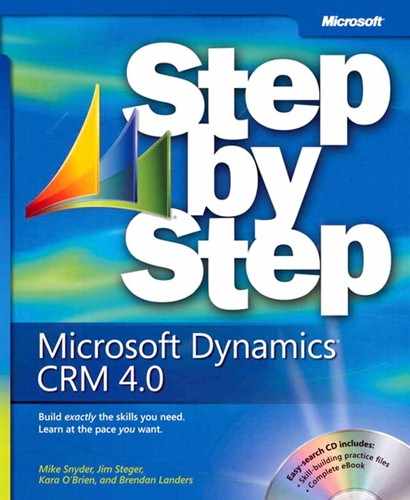Most of the records in Microsoft Dynamics CRM include values for status and status reason. A record’s status defines the state of the record. The most common status values are Active and Inactive. However, some types of records include additional status values. For example, case records can have a status value of Active, Resolved, or Canceled. Records that do not have a status value of Open or Active are considered to be deactivated (also referred to as "inactive"). Microsoft Dynamics CRM retains deactivated records in the system; it does not delete them. However, inactive records will not appear in several areas throughout the user interface, such as in Quick Find searches or lookup windows.
Important
Microsoft Dynamics CRM removes inactive records from parts of the user interface. Also, you cannot use an inactive record’s form to edit the record.
A record’s status reason provides a description of the record’s status. Status reasons vary by type of record and status value. In the case example, a record with an Active status value can have one of several status reason values: In Progress, On Hold, Waiting For Details, or Researching. Trying to understand the difference between a record’s status and its status reason can cause confusion, but you should make sure you get familiar with these important concepts. The following table illustrates how status and status reason values can vary by record type.
Record type | Status value | Status reason value |
|---|---|---|
Account | Active | Active |
Inactive | Inactive | |
Contact | Active | Active |
Inactive | Inactive | |
Case | Active | In Progress On Hold Waiting For Details Researching |
Resolved | Problem Solved | |
Canceled | Canceled | |
Phone Call | Open | Open |
Completed | Made Received | |
Canceled | Canceled |
By default, all new records that you create have an active status, but there are many reasons you might deactivate a record. For example, you might want to deactivate a record if:
A contact has changed companies or does not work for the account anymore.
An account has gone out of business.
A duplicate of the account or contact record already exists in the system.
You do not want to continue tracking interactions with the account or contact.
In this exercise, you will deactivate a contact record and then reactivate it.
Note
USE the Ben Burton contact record you created earlier in this chapter.
BE SURE TO use the Internet Explorer Web browser to navigate to your Microsoft Dynamics CRM Web site, if necessary, before beginning this exercise.
Click the Sales application area. In the navigation pane, click Contacts.
In the Quick Find box, type Burton, and then press
 .
.The Ben Burton record appears in your results.
Click the record to select it. On the grid toolbar, click the More Actions button and select Deactivate. In the dialog box that opens asking you to confirm, click OK.
Microsoft Dynamics CRM deactivates the record.
In the Quick Find box, type Burton, and then press
 .
.The Ben Burton record does not appear in your results because you deactivated the record. Microsoft Dynamics CRM does not include inactive records in the Quick Find results. Now you will reactivate the contact record.
In the view selector, select Inactive Contacts.
The list of deactivated contacts that appears includes the Ben Burton record.
Double-click the Ben Burton record to open the contact record.
Note that Microsoft Dynamics CRM disables the fields on the form so that you cannot edit the inactive record.
In the toolbar, click the Actions button, and then click Activate Contact. In the dialog box that opens asking you to confirm, click OK.
Microsoft Dynamics CRM activates the contact and enables the form fields so that you can edit it.
